Tag Archive: collaboration
September 8, 2015
by Carole Zangari -
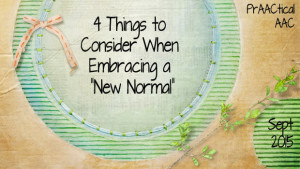
It isn’t every day that we get to hear from AAC interventionists who’ve been doing this work for decades. Today, we are thrilled to welcome back SLP Marlene Cummings from Oakland Schools in Michigan. Marlene has written several very popular posts on AAC in educational settings. (Click here to peruse them.) In this post, Marlene gets us thinking about ways to deal with change in a positive and sustainable fashion. Her passion for supporting both kids and colleagues is infectious. Enjoy! :::::::::::::::::::::::::::::::::::::::::::::::::::::::::::::::::::::::::::::::: I have the privilege, as part of a 5 member AAC Team, of supporting 28 school districts with more than 100 teams serving students with complex communication needs using AAC. The staff members and teams we support come with varied levels of knowledge, diverse experiences, and degrees of confidence. For us the new school year is just around the corner. We are already receiving calls and emails reporting... [Read More...]
Filed under: PrAACtical Thinking
Tagged With: collaboration, community, Marlene Cummings, schools, Team work
August 27, 2015
by Carole Zangari -
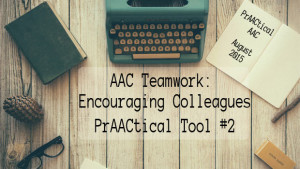
Even when everyone has good intentions, AAC implementation doesn’t happen overnight. Strengthening our resolve to learn the student’s AAC system, model it as we speak to them, provide instruction, and give ample opportunities for practice takes commitment and leadership. In the past, we’ve talked about strategies to get the team onboard with skills like aided language input, using no-tech communication boards to build language, and shared training materials. In this series, we’re sharing some printables to recognize the efforts of our team members, and keep them energized to keep going. Here is the second set of tags/bookmarks to share with your teams. You can download them here. If you missed the first set, you can get those here.
Filed under: PrAACtical Thinking
Tagged With: aided language input, collaboration
November 25, 2014
by Carole Zangari -
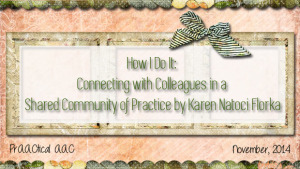
I had the pleasure of meeting Karen Natoci Florka last month when I visited Michigan and am delighted that she was willing to introduce us to the Shared Community of Practice from the team at The Communication Matrix. Karen is an SLP who has served students aged 3-26 with various physical, sensory and intellectual challenges at Wing Lake Developmental Center (Detroit area) since 2001. She is a part time lecturer at Wayne State University where she teaches a course entitled “Communication Acquisition and Educational Interventions for Students with Moderate to Severe Impairments.” She is part of the Communication Matrix Charter group. Click on the image below to learn more. The Communication Matrix is growing into a Shared Community of Practice! I remember the first few weeks in my new job at a wonderful, magical, school for children with complex communication needs. It was time for my first evaluation. These amazing students were challenging! They seemed... [Read More...]
Filed under: PrAACtical Thinking
Tagged With: collaboration, Communication Matrix, Community of Practice, connection, How I Do It, Karen Natoci Florka
August 6, 2014
by Carole Zangari -
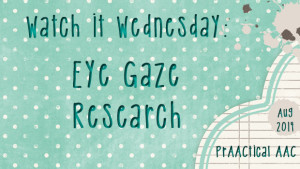
Today, we’ll take a look at a collaborative effort by researchers at University College London (Department of Developmental Science), Great Ormond Street Hospital for Children (Neurodisability Service), and Barnsley Hospital. These researchers are investigating the eye gaze patterns of children with cerebral palsy who have little or no functional speech. Could tracking eye movements be a useful way to assess language skills? This is a line of research we will be watching. Direct Link: http://www.ucl.ac.uk/gaze
Filed under: PrAACtical Thinking
Tagged With: collaboration, eye gaze, research
September 6, 2013
by Carole Zangari -
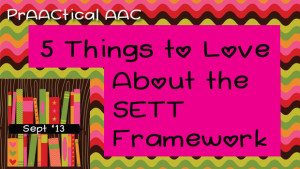
The SETT Framework by Dr. Joy Zabala (Director of Technical Assistance at CAST) is a widely used approach for collaborative decision-making in AT. It’s a tool we love, teach about, and use, but many SLPs aren’t that familiar with it. Here are some of the reasons we think it deserves your consideration. 1. It gives everyone a common focus. We all look at the student from our own perspective and sometimes fail to think about how our priorities intersect with those of other team members. The SETT Framework helps us to all look at the same thing at the same time. 2. Defensive, who me? When you focus on a framework or process, people are less likely to become defensive when we’re trying to make things better for the student. 3. It becomes a way of thinking. Teams that are in the habit of using the SETT Framework are generally... [Read More...]
Filed under: PrAACtical Thinking
Tagged With: assessment, classroom, collaboration, general education, Joy Zabala, SETT
August 17, 2013
by Carole Zangari -
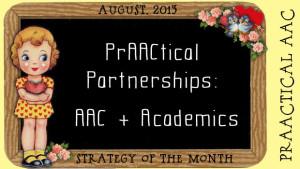
Like many of you, we are always racking our brains trying to help students who use AAC be successful academically. Because we serve these students in a clinical setting, we could easily pass on the opportunity to align our AAC goals with academic standards but what would be the fun in that? Here are some things we try to think about with school-aged kids who have AAC needs. SLP to SLP If it takes a village to raise a child, how many people does it take to help a kids with AAC needs to develop communicative competence and succeed academically? It boggles the mind. As SLPs, message is this: We have to work together. Many kids who use AAC have private therapies in addition to their school services, and yet, we rarely connect. We have to find a way to do a better job at this so that kids with... [Read More...]
Filed under: Strategy of the Month
Tagged With: assessment, classroom, collaboration, education, testing
August 3, 2013
by Carole Zangari -
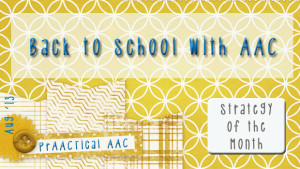
Here in the US, August is Back-to-School month. Throughout this month, we’ll try to post ideas and resources to help make the transition back to school a smooth and successful one. One of the most important things for students who use AAC is having their SLPs, teachers, and families on the same page. They each have a different but very intense relationship with the student’s AAC system. Here are some prAACtical thoughts on getting everyone on the same page. 1. Develop a communication profile of the student: In the initial weeks, try to get a baseline of how the student is communicating at the start of the year. For beginning communicators, we track things like their communicative intents (WHY they are communicating), modalities (HOW they are communicating), and the frequency of their communication. We’ve written about one of our favorite tools for this, the Communication Matrix. 2. Share what you know:... [Read More...]
Filed under: Strategy of the Month
Tagged With: collaboration, Communication Matrix, education, forms, gesture dictionary
April 19, 2013
by Carole Zangari -
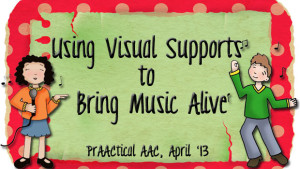
When I first met our guest blogger almost 20 years ago, she was using more visual supports in her music therapy sessions with kids who had ASD than most SLPs were using in their language therapy. Marlene Sotelo has worn many hats in her professional life, but her passion for helping people with ASD communicate more effectively seems to have permeated all of them. In this post, she discusses some of the ways she uses visual supports to help make music therapy effective. Music is a powerful force that transcends time, cultures, and languages. It can transport you to the past, and bring you hope and excitement for the future. In addition, music can be an effective tool in teaching children with varying abilities. The predictability, rhythmic patterns, and repetitive nature of the structure music lends itself to the development of language, cognitive skills, and motor skills, especially for individuals... [Read More...]
Filed under: PrAACtical Thinking
Tagged With: academics, ASD, choice making, collaboration, Marlene Sotelo, music, music therapy, participation, visual supports
October 11, 2012
by Carole Zangari -
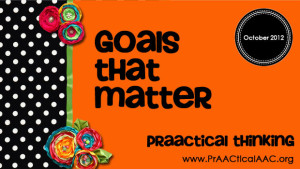
Like some of you, we often get asked “The Question.” People sometimes ask us to give them a recommendation about what AAC device or app is best for a particular individual. When the question comes from a parent or therapist whom we don’t know, it’s understandable. But when it is from a clinician we’ve taught, (who should know better), it’s a bit baffling. Obviously, we’d never make that kind of recommendation without having done an evaluation, or at least reviewing someone else’s assessment. We dread “The Question.” On the other hand, there are a lot of things that we wish people would ask that relate to how to help the communicator develop strong skills. This post relates to to one of those type of questions. “What should I work on?” “What kinds of AAC goals should we write?” We like those kinds of questions and our answers generally have one... [Read More...]
Filed under: PrAACtical Thinking
Tagged With: collaboration, goal bank, goal setting, goals, objectives
May 17, 2012
by Carole Zangari -
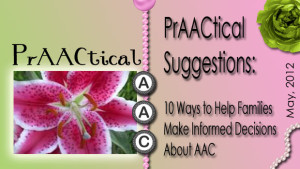
– In one of my AAC classes, we’ve been talking about how to help families make informed decisions. To do that, they need to have solid information presented clearly, in digestible bites from a trusted source. When we don’t have that information, it is easy to fall prey to fads and/or adopt a herd mentality and do what everyone else is doing. Here are some suggestions for supporting families through the AAC decisions they will need to make. – 1. Have direct conversations about the pros and cons of the available options. For example, if the family expressed interest in an iPad with AAC apps over a full fledged SGD, then we’d have to be prepared to reiterate the merits and drawbacks of each. 2. Share a process for making AAC decisions rather than attempting to take the decision out of their hands. For example, you may want to encourage... [Read More...]
Filed under: PrAACtical Thinking
Tagged With: collaboration, families, FAQs









